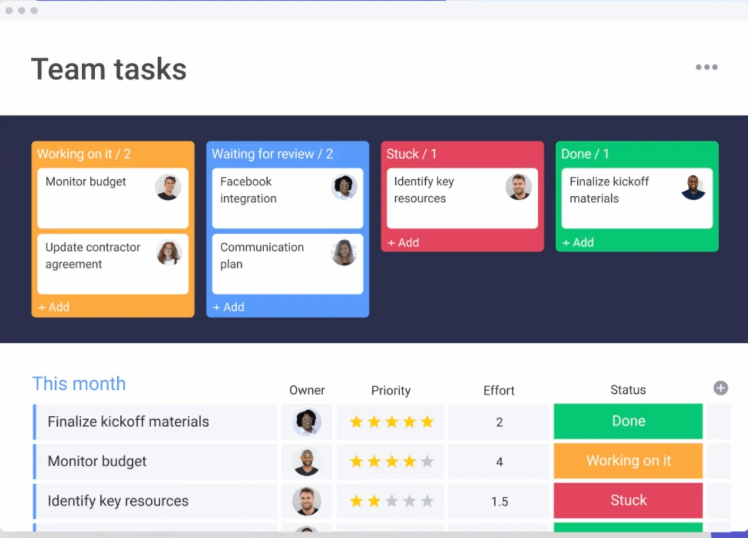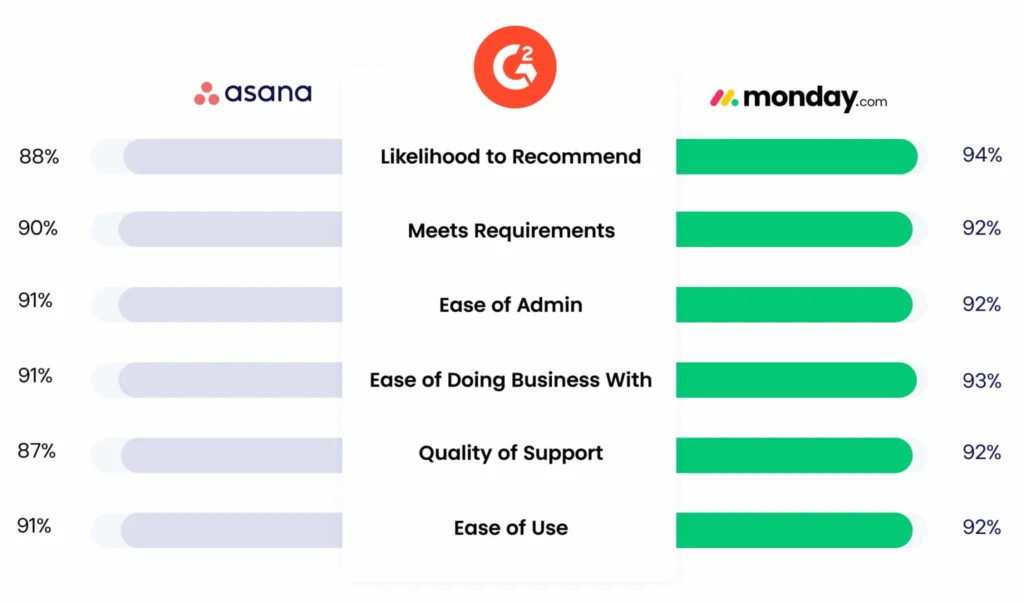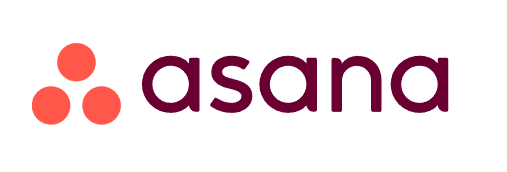Unsure whether to choose Monday.com or Asana for your team? 🤔
Both are powerful project management tools, but how do you know which one is the right fit for your needs?
Imagine effortlessly managing tasks, collaborating in real-time, and streamlining your workflow all while boosting team productivity.

This guide will help you decide between Monday.com and Asana, ensuring you choose the perfect tool to save time, improve efficiency, and scale your team’s success.
So, let’s get started! 🚀
Detailed Features Comparison: Monday.com vs Asana
In this section, we’ll explore the core features of both Monday.com and Asana, providing a side-by-side comparison to help you decide which platform best suits your team’s needs and workflows.
Let’s dive into this Monday.com Review alongside Asana’s features to see which platform fits your needs.
1. Task Management
Monday.com:
Monday.com offers highly customizable workflows, enabling teams to create tasks, set priorities, track progress, and assign deadlines.
It supports multiple views like Gantt, Timeline, and Kanban, making it ideal for teams needing flexibility and scalability in task management.
Asana:
Asana simplifies task management with straightforward features like task assignments, due dates, and priority labels.
It offers List, Board, and Calendar views for easy tracking, and basic task dependencies help teams stay aligned. Asana’s focus is on ease of use and simplicity.

2. Automation
Monday.com:
Monday.com provides advanced automation capabilities, allowing teams to automate repetitive tasks like moving tasks, sending notifications, and setting reminders.
Automations are available in all paid plans, with higher-tier plans offering more actions per month and more complex workflows.
Asana:
Asana offers Workflow Builder to automate task assignments, due dates, and approvals. Automations are included in all paid plans, but the number of actions is limited.
Asana’s automation features are simple but efficient for teams looking to streamline their workflow without extensive complexity.
3. Integrations

Monday.com:
Monday.com supports integrations with a wide range of tools like Google Workspace, Microsoft Teams, Slack, Trello, and Zoom.
Curious about Monday.com vs Jira integration? See how it works here.
It also provides API access for custom integrations, making it highly flexible for teams using multiple platforms across their operations.
Asana:
Asana integrates seamlessly with popular tools like Slack, Google Workspace, Microsoft Teams, Dropbox, and Zoom.
It also supports custom integrations via Zapier, allowing teams to connect Asana with other apps. The integrations are comprehensive but less flexible than Monday.com’s API options.
4. Collaboration and Communication
Monday.com:
Monday.com offers a robust platform for collaboration with features like task comments, file sharing, team communication, and real-time updates.
It supports guest access, making it easy to work with external collaborators and share project details securely.
Asana:
Asana’s collaboration tools include task comments, file attachments, and tagging team members.
It enables seamless communication within tasks and projects, while project conversations allow teams to discuss progress and share feedback in a centralized space.
Pricing Comparison
Monday.com Pricing Plans:

| Plan | Cost | Description |
|---|---|---|
| Free | $0 (for up to 2 users) | Ideal for individuals or very small teams. |
| Basic | $9/seat/month (billed annually) | Affordable for small teams looking to scale. |
| Standard | $12/seat/month (billed annually) | Perfect for teams needing more collaboration. |
| Pro | $19/seat/month (billed annually) | Best for complex workflows and larger teams. |
| Enterprise | Custom Pricing | Tailored for large organizations with enterprise needs. |
💡 Tip: Looking to save on your subscription? Use a Monday.com coupon code to get a discount on your chosen plan!
Asana Pricing Plans:

| Plan | Cost | Description |
|---|---|---|
| Personal | $0 (for up to 10 users) | A great starting point for individuals and small teams. |
| Starter | $10.99/user/month | Perfect for small teams with growing needs. |
| Advanced | $24.99/user/month | Best for teams needing advanced features and scale. |
Customer Reviews: Monday.com vs Asana – Monday.com Takes the Lead
Based on customer reviews, both Monday.com and Asana receive high praise for their project management capabilities.

However, Monday.com slightly edges out Asana in key areas such as Likelihood to Recommend, Ease of Admin, and Ease of Doing Business With, with 94% of users likely to recommend it.
Both platforms score similarly in Meets Requirements, Quality of Support, and Ease of Use, making them both strong contenders in the project management space.
🏆 Monday.com vs Asana: Which One Wins for Your Team?
When comparing Monday.com and Asana, Monday.com emerges as the winner for teams looking for flexibility and advanced customization.
It’s 100% trusted by brands like Coca-Cola, Adobe, and Uber for managing complex workflows and scaling operations efficiently.
While Asana offers simplicity and ease of use, Monday.com stands out with its highly customizable workflows, powerful automation features, and broader integrations.
This makes it the top choice for teams needing more complex project management tools with the ability to scale efficiently.
Pros and Cons: Monday.com vs Asana
Monday.com
Pros:
- Highly customizable workflows and dashboards.
- Advanced automation features.
- Powerful collaboration tools (comments, file sharing).
- Wide range of integrations (Slack, Zoom, etc.).
- Scalable for teams of any size.
Cons:
- Steeper learning curve.
- Higher pricing, especially for larger teams.
- Can be complex for smaller teams or basic needs.
Asana
Pros:
- Easy-to-use, user-friendly interface.
- Strong task management features.
- Free plan available for teams of up to 15 members.
- Good integrations with Slack, Google Workspace, etc.
Cons:
- Limited customization options.
- Fewer automation features in lower plans.
- Can get expensive for larger teams or advanced features.
- Advanced reporting requires higher-tier plans.
Final Verdict
Monday.com is the clear Winner🏆 for teams needing advanced customization, automation, and scalability. Its powerful features, extensive integrations, and ability to handle complex workflows make it ideal for large teams and businesses with growing needs.


Asana, while simpler and more user-friendly, is better suited for smaller teams or those looking for straightforward task management without the need for deep customization.
If you need flexibility and robust tools to manage projects, Monday.com is your best choice!
🔗 Must Read:
- Monday.com vs ClickUp Comparison 2025: Best for Your Team?
- Monday vs Notion (Comparison) – Which One Is Best?
FAQs
1. Can I use Monday.com or Asana for free?
Monday.com offers a free plan for up to 2 users, with limited features like 3 boards and basic task management.
Asana provides a free plan for up to 15 users, offering core features like task creation, list views, and calendar.
2. Which platform is better for remote teams?
Monday.com is ideal for remote teams due to its advanced collaboration features, custom workflows, and real-time updates.
Asana is also great for remote teams, offering task tracking, deadlines, and communication tools like comments and notifications.
3. Which platform is easier for new users?
Asana is more beginner-friendly due to its clean, simple interface and straightforward task management features.
Monday.com offers a wider range of customization, but its complexity may overwhelm new users or smaller teams.